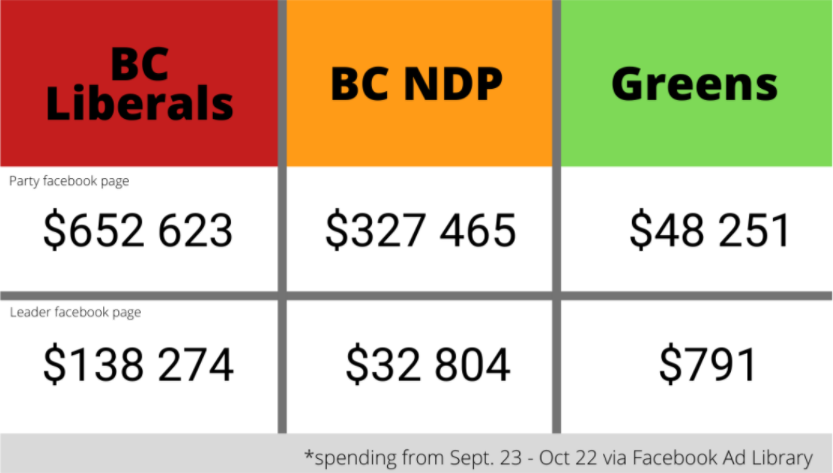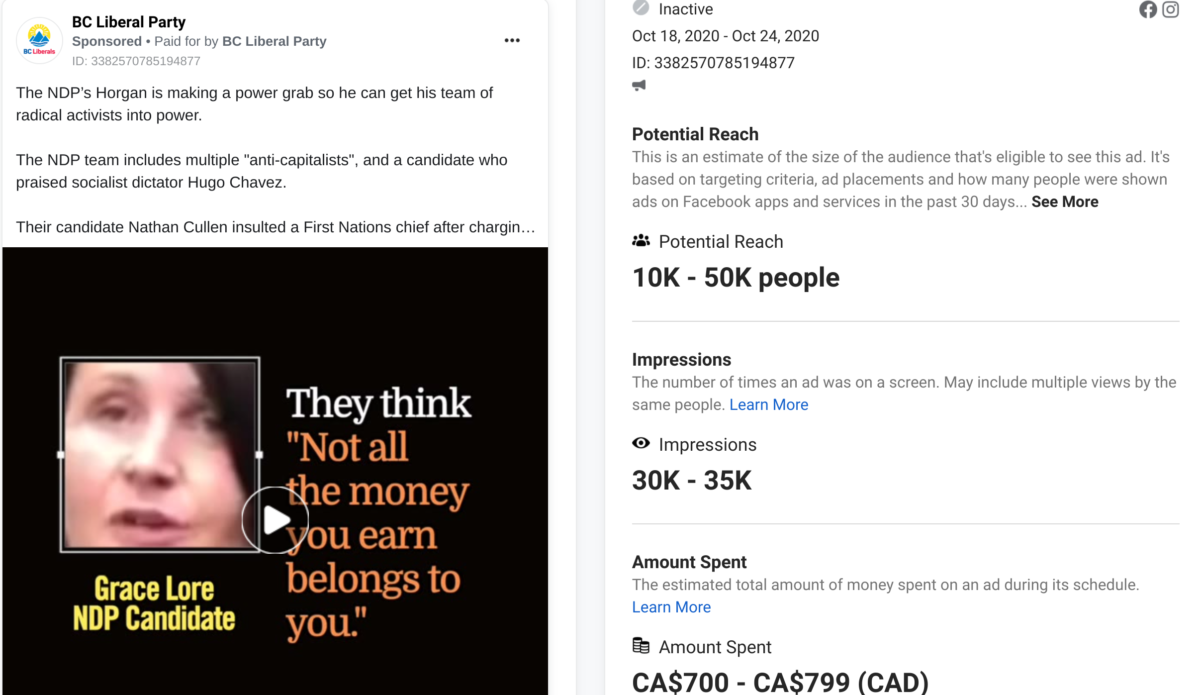The real winner of the B.C. election? Mark Zuckerberg

As the mail-in ballots are counted and the election signs are taken down, political parties’ Facebook ads will disappear from British Columbians’ feeds. Collectively, the top three parties’ Facebook pages, their leaders’ pages, and the 10 highest-spending candidates spent almost $1.3 million on Facebook ads from Sept. 23 to Oct. 22.
While the parties tried to market themselves as the best people to lead the province’s COVID-19 recovery, they were dolling out thousands of dollars to one of the world’s largest tech companies.
BC Liberals spent more than double NDP
The Liberals might be fiscally conservative on paper, but they were certainly the biggest spenders when it came to Facebook ads. Of that $1.3 million, $846 910 was spent by either the Liberal party or the eight highest-spending Liberal candidates. The 10 highest-spending candidates were mostly Liberals, with Conservative leader Trevor Bolin and NDP candidate Andrew Mercier as the only exceptions.

The bill for these ads will ultimately be footed by British Columbians. According to B.C.’s election laws, 50 per cent of the money spent during a campaign is eligible for reimbursement as long as a party gets five per cent of the votes or a candidate gets 10 per cent of the vote.
Mid-way through the campaign, the party ramped up their spending massively.
Two weeks before the election, the BC Liberals spent $235 255 on Facebook ads including $200 491 for their party’s Facebook page and $34 764 for leader Andrew Wilkinson’s page. This was the same week that the Liberals were grappling with bad the extenpress because of problematic comments made by two of their candidates. Their spending during this week placed them $240 993 above what the NDP had spent in the election, and ranked them as the twelfth highest spender among all Canadian political advertisers since June 2019.
And then election week came. The Liberals coughed up even more money for ads — moving up to become the ninth highest spender among all Canadian political advertisers. By election day, the Liberal party and Wilkinson’s page had spent $790 897 on ads, outspending the NDP and their leader John Horgan’s page by $430 628.
The NDP noticed this sudden spur in ad spending. The Vancouver Sun reported that they sent an email requesting donations to spend on last-minute ads because the Liberals were spending $40 000 every day on Facebook ads.
“Here’s the thing: We can be outspent and still win — but if we’re outspent by THAT much, we risk being drowned out,” Tyler Michaels, the NDP’s media manager, wrote in the email.
There’s a method to the madness … sort of
In the B.C. election, the parties used Facebook’s political advertising to target different demographics of voters. However, their strategies were very different. The Vancouver Sun described how the NDP and Greens sent specific ads to smaller numbers of people, spending less per ad but purchasing a larger number of individual ads. In contrast, the Liberals used a “blanket” strategy, purchasing fewer ads but sending ads to a larger audience.
Some ads in Facebook’s ad library, paid for by the Liberals, targeted three non-incumbent NDP candidates and called them “radical” “anti-capitalists,” claiming that they support Hugo Chavez and taking their quotes about the economy out of context. Grace Lore, the candidate for Victoria-Beacon Hill, was quoted saying “not all the money you earn belongs to you.”
The Martlet found some of the ads in this set were shown exclusively to men. These ads were shown in the middle of the campaign and in the final week.

Kevin Chan, Facebook Canada’s head of public policy, told Canadian Press that the platform would be deleting posts and ads encouraging voter suppression. Independent fact-checkers with Agence France-Press and Radio-Canada were responsible for fact-checking election posts and ads.
It’s unclear how many posts or ads were flagged by the fact-checkers.
The parties’ different strategies were sculpted by their campaigns. Though advertisers can target ads to certain groups based on demographics or interests, the mechanics of which ads are shown to which users is determined by Facebook’s algorithm and ad auctions.
Did these ads change B.C. election outcomes?
The short answer is no. As the BC Liberals revved up their spending in the last two weeks, their polling numbers went down.
The long answer is that Facebook ads achieve other goals beyond electoral outcomes by giving the biggest spenders a larger audience. The amount spent is a bid, not a guarantee to reach an audience, and spending money on Facebook ads is a convoluted process that involves a mind-boggling amount of spending and user data every second.
Each user’s Facebook feed is controlled by an algorithm. This orders each feed in a manner that Facebook thinks will make users keep scrolling and, in turn, give them more ad revenue. The data Facebook has, based on users’ activity both on and off the app, is used to determine who is shown what ads. To get an ad on the coveted space on someone’s feed, millions of advertisers are in a constant bidding war over that space.
In the ad auction, Facebook uses the amount a page is willing to spend and the estimated engagement levels (likes, shares, comments) an ad will receive to decide who wins any given auction. That’s a simplified explanation of the process that goes on behind our feeds every second.
This means that, roughly, political parties that are willing to spend more have a better chance of getting their ads seen by their targeted audience. The complicated processes of buying ads, targeting demographics, and competing in bids is a black box — and one Facebook’s ad library only begins to crack.
Though data on spending by advertisers, like B.C. political parties, is available through the library, the level of detail provided about who has seen an ad is low. The library only shows the age, gender, and province of those who saw the ad and an estimation of the amount spent and the number of people reached.
Given the high spending by the BC Liberals, it’s clear that their message got out to more voters online. The extent of that and the intricacies of each party’s targeting tactics is a secret we’ll never know.








